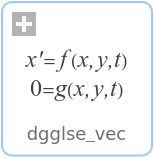WOLFRAM SYSTEM MODELER
dgglse_vecSolve a linear equality constrained least squares problem |
|
Wolfram Language
In[1]:=

SystemModel["Modelica.Math.Matrices.LAPACK.dgglse_vec"]
Out[1]:=

Information
This information is part of the Modelica Standard Library maintained by the Modelica Association.
Lapack documentation
Purpose
=======
DGGLSE solves the linear equality-constrained least squares (LSE)
problem:
minimize || c - A*x ||_2 subject to B*x = d
where A is an M-by-N matrix, B is a P-by-N matrix, c is a given
M-vector, and d is a given P-vector. It is assumed that
P <= N <= M+P, and
rank(B) = P and rank( (A) ) = N.
( (B) )
These conditions ensure that the LSE problem has a unique solution,
which is obtained using a generalized RQ factorization of the
matrices (B, A) given by
B = (0 R)*Q, A = Z*T*Q.
Arguments
=========
M (input) INTEGER
The number of rows of the matrix A. M >= 0.
N (input) INTEGER
The number of columns of the matrices A and B. N >= 0.
P (input) INTEGER
The number of rows of the matrix B. 0 <= P <= N <= M+P.
A (input/output) DOUBLE PRECISION array, dimension (LDA,N)
On entry, the M-by-N matrix A.
On exit, the elements on and above the diagonal of the array
contain the min(M,N)-by-N upper trapezoidal matrix T.
LDA (input) INTEGER
The leading dimension of the array A. LDA >= max(1,M).
B (input/output) DOUBLE PRECISION array, dimension (LDB,N)
On entry, the P-by-N matrix B.
On exit, the upper triangle of the subarray B(1:P,N-P+1:N)
contains the P-by-P upper triangular matrix R.
LDB (input) INTEGER
The leading dimension of the array B. LDB >= max(1,P).
C (input/output) DOUBLE PRECISION array, dimension (M)
On entry, C contains the right hand side vector for the
least squares part of the LSE problem.
On exit, the residual sum of squares for the solution
is given by the sum of squares of elements N-P+1 to M of
vector C.
D (input/output) DOUBLE PRECISION array, dimension (P)
On entry, D contains the right hand side vector for the
constrained equation.
On exit, D is destroyed.
X (output) DOUBLE PRECISION array, dimension (N)
On exit, X is the solution of the LSE problem.
WORK (workspace/output) DOUBLE PRECISION array, dimension (MAX(1,LWORK))
On exit, if INFO = 0, WORK(1) returns the optimal LWORK.
LWORK (input) INTEGER
The dimension of the array WORK. LWORK >= max(1,M+N+P).
For optimum performance LWORK >= P+min(M,N)+max(M,N)*NB,
where NB is an upper bound for the optimal blocksizes for
DGEQRF, SGERQF, DORMQR and SORMRQ.
If LWORK = -1, then a workspace query is assumed; the routine
only calculates the optimal size of the WORK array, returns
this value as the first entry of the WORK array, and no error
message related to LWORK is issued by XERBLA.
INFO (output) INTEGER
= 0: successful exit.
< 0: if INFO = -i, the i-th argument had an illegal value.
= 1: the upper triangular factor R associated with B in the
generalized RQ factorization of the pair (B, A) is
singular, so that rank(B) < P; the least squares
solution could not be computed.
= 2: the (N-P) by (N-P) part of the upper trapezoidal factor
T associated with A in the generalized RQ factorization
of the pair (B, A) is singular, so that
rank( (A) ) < N; the least squares solution could not
( (B) )
be computed.
Syntax
(x, info) = dgglse_vec(A, c, B, d)
Inputs (4)
| A |
Type: Real[:,:] Description: Minimize |A*x - c|^2 |
|---|---|
| c |
Type: Real[size(A, 1)] |
| B |
Type: Real[:,size(A, 2)] Description: Subject to B*x=d |
| d |
Type: Real[size(B, 1)] |
Outputs (2)
| x |
Type: Real[size(A, 2)] Description: Solution vector |
|---|---|
| info |
Type: Integer |
